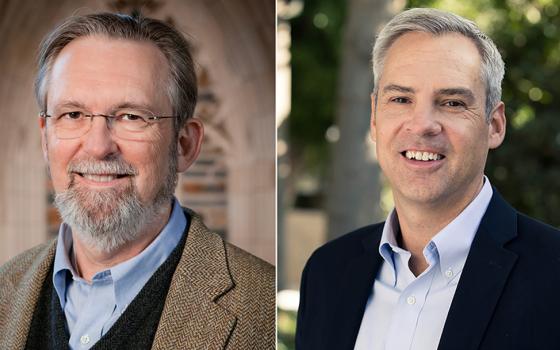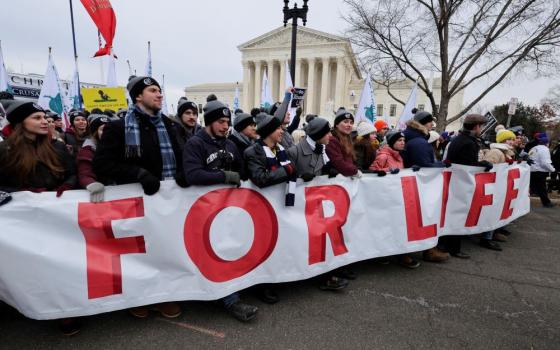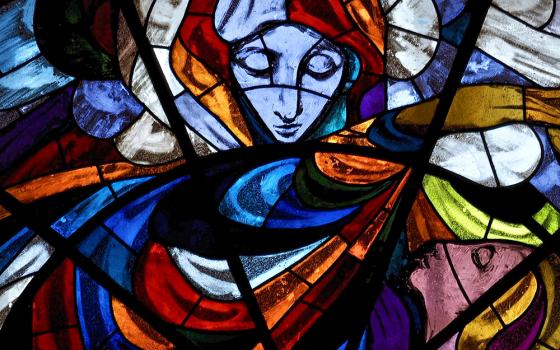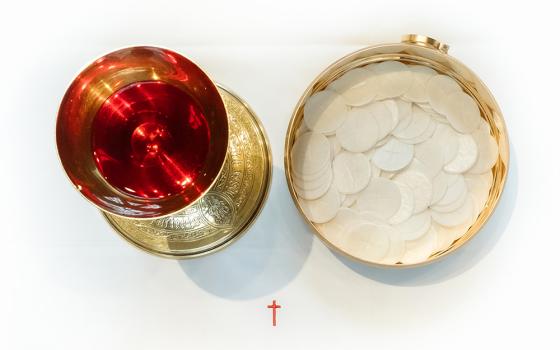I often think that if at the age of 10 months I had possessed the kind of rational power I use today, I would never have learned to walk. I would have tried it out a few times, but after discovering that I could fall backward, forward, on my side and on my face, I would have come to the conclusion that I was destined to be a sitter — perhaps a crawler, but certainly not a walker. That two-legged stuff was for those more athletic — perhaps longer-legged — than I. Happily, I didn’t think then as I do now; nature was stronger than my fear of falling, and my ability grew and my legs were finally ready. I gradually learned from tumbling, and I mastered the skill of moving on two feet. Now, I can even walk and talk and spill coffee on myself while doing it.
I suspect that Jesus understood that his disciples thought like that. When they walked with him, they had often been daring — and as often as not, they fell flat. When Jesus’ experience of the cross and resurrection showed them what he was really all about, they were awed, grateful and anxious for his glory to shine throughout the universe. With that heady expectation, they asked, “Are you now going to restore the kingdom to Israel?” (italics added).In reply, exhibiting more patience than Job, Jesus said in essence, “It’s not for you to know God’s timetable, but rather to be witnesses of God’s love, a mystery of grace you must unravel in your own lives so that you can share it for real, not simply by spouting off on your ideas about me.” Jesus was preparing them to walk on their own.
Then, Jesus said, “Behold I am sending ... .” At this point, we expect to hear a reprise of Chapters 9 and 10 in Luke, in which Jesus sent the disciples out on a mission. But no, he said he was sending “the promise of my Father upon you.” He ended that statement with the surprising command, “Stay in the city until you are clothed with power from on high.” Their apostolic legs weren’t quite ready yet; grace had not yet enabled their natures sufficiently.
We should note here that Jesus was speaking to “his disciples.” He didn’t address one in particular or each in his or her turn;he spoke to them all. They were to wait, they were going to be clothed, they had to be with and for one another in the process. Jesus was establishing them as a community of witnesses, women and men who had begun the adventure together and had learned by walking with Jesus. He would never again be with them in the same way, and so the only way they could continue was together. Only together could they discern when their message had come from on high and was more than auto-inflation. (They knew each other well enough to catch on when ego, not mission, was the driving force, and they had learned from Jesus how to call one another out.)
Jesus sent his disciples to wait together before they would go out. Luke tells us that they went back to Jerusalem and prayed in the Temple. A bit like Mary at the beginning of the Gospel, they went into a period of waiting, of allowing God’s grace to gestate in them individually and as a community. Surely, they were restless, anxious to do something, but they knew not what. The best they could say to one another during this period was, “He told us to wait. Something else is going to happen.”
This time of waiting may have been the hardest of all. Unlike Advent when we listen to the prophecies of what is to come, this kind of waiting is a time of transition from the known to the unimaginable. The discipline of this time requires that we drop our expectations enough to be open to what God will work in and among us.
In the church year, this is a short period — a week or 10 days. In our spiritual life and the life of the church, the calendar doesn’t count. There are times when we feel the absence of the Lord and think that there is nothing we can do — that we were never cut out to be real disciples. At that point, all we can do is pray while we wait for the Spirit to show us the next step. In the 17th century, Jean Pierre Médaille, a Jesuit spiritual director, advised people, “Never go ahead of grace by an imprudent eagerness, but quietly await its movements, and when it comes to you, go along with it with great gentleness, fidelity, and courage” (Maxim 84). Jesus simply said, stay together and wait. Pray and the Spirit will come — in God’s good time.
ACTS 1:1-11
In Luke’s Gospel, Jesus’ ministry begins with 40 days in the desert. The Acts of the Apostles, Volume II of Luke’s Gospel, begins with the explanation that Jesus spent 40 days presenting himself to his disciples, assuring them that he was present and reprising all that he had taught them in their time together and by the events of his passion and resurrection.
In a similar way, Luke’s Gospel ends with Jesus’ being taken up into the heavens, and Acts begins with a variation on the same story. We might say that at the end of the Gospel, Luke focuses on Christology and Jesus’ exaltation. In the Acts of the Apostles, as the very title implies, Luke gives us a Gospel about discipleship in the absence of Jesus’ human presence.
Although Jesus had sent his disciples on mission while he was with them (Luke 9, 10), now his first instruction is to wait. Whatever they think they understand, whatever they might think they could teach, remains incomplete until they have the experience of being filled with his Spirit. Everything they had undergone before — John’s baptism, their discipleship, the crushing experience of Jesus’ death and their overwhelming encounters with him as risen — all of that was simply a prelude. The decisive event of their faith life, their baptism with the Holy Spirit, was yet to come, and all they could do was wait for it.
Luke’s opening in Acts is a practical story that puts flesh on the message of John 16:5-7. In that part of the last discourse, Jesus talked about going away, saying, “I am going to the one who sent me … it is better for you that I go. For if I do not go, the Advocate will not come to you.” Luke, the only evangelist who really depicts Jesus’ ascension, tells us about it twice so that we will get the message: Jesus’ departure prepares the way for the fulfillment of our vocation to discipleship.
PSALMS 47:2-3, 6-7, 8-9
Psalm 47 depicts what scholars refer to as an “enthronement ritual.” When we think of this, we can well understand that the roots of theater are in religious ritual. With this psalm, we realize how a people, who knew earthly potentates and thought of God as their true king, imagined God’s enthronement as the crowning liturgy of all time: “God mounts his throne to shouts of joy; a blare of trumpets for the Lord.”
This may be one of the most difficult images for us to appreciate, at least if we concentrate on the imagery rather than the mood of the message. Ideas of kings and thrones are far from our real world and hardly our ideals when it comes to governance. But if we try to understand the mood that the psalm is trying to convey, another world opens up.
If the psalmist were addressing 21st century people, she or he might say: “Just imagine what the world will look like when all people and nations are at peace with each other and God, under whatever form God has been revealed to them!” For the ancient Israelites, God was the king of the Earth. For others, God is life or wisdom, Allah or the Father revealed by Jesus. But no matter how peoples have come to apprehend God’s self-revelation, all who recognize God live in the hope that God’s will is going be done and that God will be appreciated by all humanity. Today’s psalm imagines the day when that will happen in the sight of all the living.
HEBREWS 9:24-28; 10:19-23
The author of the Letter to the Hebrews is bending over backward to demonstrate that Christ is the fulfillment of everything God had wanted to accomplish in and for Israel throughout her history. The people had developed a religious practice of sacrifice, which reached its peak in the actions of the high priest who would enter the holy of holies, the symbol of heaven. Going in, the priest represented the repenting people. When he returned to the people, he was clothed in white as a symbol of God coming forth to reconcile the people. Hebrews tells us that all the priesthood had attempted has been fulfilled and surpassed.
The author of Hebrews says that the priests used to enter the sanctuary time and again, repeating the human approach to God and God’s approach to humanity. But that is past. Now, we are no longer doing theater or contemplating symbols; we have entered a new reality. God became human to show God’s unrelenting, everlasting offer of reconciliation to humanity. Jesus Christ has fulfilled everything the rituals symbolized.
While exalting Christ, this reading also reminds us that no matter how beautiful, relevant or fulfilling our earthly liturgy or rituals are, they are, at best, shadows of reality. The blood of Jesus, the proof of God’s invincible love, is our invitation to enter into the true sanctuary, not a human edifice built to be set off from the profane world, but the very realm of God that will one day permeate all of creation in a tangible way.
This selection from Hebrews reflects the themes of the Ascension as it reminds us of Christ’s victory and exaltation. In that, it is an invitation to imagination and contemplation of what it means to say that Christ is in the presence of God and, as the psalm proclaims, that Christ is king of all the Earth.
This passage reminds us that as Christians we acknowledge that all the religious symbols we devise are “made by hands.” They are fabrications that reflect more of their creators than of the God they are supposed to represent. This reading invites us to open our minds, as Paul would say, to more than we could ever ask or imagine.
LUKE 24:46-53
Today’s Gospel reading picks up in the middle of the story of Jesus’ appearance to the disciples in Jerusalem (Luke 24:36-49). As Luke tells the story, Jesus became present in the midst of his disciples and greeted them with peace. Then, as if his being with them were the most natural thing in the world and he couldn’t conceive of why they were “startled and terrified,” he told them not to wonder and worry, but to look and recognize him just as he was — the risen crucified one. To help them distinguish between him and a ghost, he asked for a bit of fish to eat. Then, echoing the Emmaus conversation, he gave them his last explanation of what it all meant. One more time, he told them what he had been trying to teach them. He finished that teaching with the opening words of today’s Gospel.
When Jesus said, “Thus it is written,” he wasn’t inviting his disciples to run to the synagogue scrolls to proof-text his next statement. Instead, he was assuring them that everything he had taught them about his suffering and resurrection had been God’s plan from the beginning. The last reminder Jesus gave his disciples was the assurance that God’s chosen one was no conquering king who would rout all enemies with his power. The Messiah sent by God was one who had to suffer. He would go through absolutely everything that human beings go through — including real temptation. But on the third day, that is, on God’s own timetable, he would rise so that the message of his life could be preached throughout the whole world.
That is the entire Gospel message in a nutshell. Jesus had accomplished it. He had revealed that the deep purpose and goal of human life is union with the God of self-giving love. By accepting death, and not just ordinary human mortality, but death in the form of a violent rejection of his person and message, Jesus had confronted the false gods of self-serving religion, prestige, coercive power and wealth. His resurrection was God’s unqualified affirmation of his life and message. The resurrection was God’s unequivocal statement that Jesus was a true image of the divine.
What was left? Was this the end of history?
Jesus told them, “You are witnesses to all these things.” Calling them witnesses was a way of calling them to be memory-keepers, testifiers and replicators — potential martyrs for the cause. Jesus then instructed them to wait together in prayer until God would send them out.
Jesus said, “I am sending the promise of my Father upon you; but stay in the city until you are clothed with power from on high.” That’s right. Jesus told them, “You are witnesses, so stay put.” That meant that they were to become witnesses to God’s power, not their own perceptions or projections.
What was left was their vocation to allow God to act through them as God had acted through Jesus. For that, they needed the power of the Spirit who had filled Jesus — and they had to wait for God to grant it in God’s own good time.
The feast of the Ascension of the Lord is the inverse and the completion of the feast of the Nativity. The celebration of Christ’s birth begins with the story of God asking for a home in humanity, beginning with the Annunciation and Mary’s gift of self to allow that to become a reality. At his ascension, Christ brings that phase to an end and promises to send the Spirit so that all people may become like Mary, overshadowed by the Holy Spirit and bearers of Christ to the world.
This is a feast that calls us to awaken our imagination. The Gospel and the psalm invite us to contemplate Christ’s exaltation: The fulfillment of the resurrection, the revelation that everything Christ was, said and did was a revelation of who God is. The reading from Hebrews not only invites us to imagine Christ’s reality in God, but also reminds us that our deepest theologies and best rituals are but feeble attempts to represent the truth of who God is. Luke’s depiction of the Ascension in Acts underlines our weakness and at the same time reminds us that God will work with it when we are willing to wait for the Holy Spirit to lead the way.
Planning: Ascension
By: Lawrence Mick
Whether you celebrate the Seventh Sunday of Easter or the Ascension today is a decision beyond your control. That has been determined by the bishops of each province (group of dioceses). Whichever is the case for you, there are lots of other decisions to make for the celebration of Ascension.
First, notice that the Missal has a separate set of prayer texts for a vigil Mass on the preceding afternoon or evening. The readings stay the same, but the prayers are different. This makes it easy to use those texts, since they do not require a different homily or special instructions for the lectors and musicians.
However, there are also two choices for the second reading. The first one in the Lectionary is from Cycle A (Ephesians) and the second from Cycle C (Hebrews). The Hebrews passage is reflected in the prayer over the offerings in the vigil texts: “that we may approach with confidence the throne of grace.” That might argue for using it for a vigil Mass and maybe for using that prayer even in the Mass of the day.
In a similar pattern, the first option for the opening collect of the Mass during the day reflects the theme of the body of Christ that appears in the reading from Ephesians. The second option for the opening prayer seems rather weak and might lead people to think that Christ is no longer here. The body of Christ is a good theme to pick up, whatever readings and prayers you use, since the Ascension does not mean Christ is gone from our world but that he is present now in us who form Christ’s body.
Another aspect of that truth is suggested in the prayer after Communion for the Mass during the day: “where our nature is united with you.” Because we are part of the body of Christ, we are drawn into the life of the Trinity, a process the Eastern church calls theosis. You’ll find that theme echoed in the second option for the preface today: “that he might make us sharers in his divinity.” The first preface option, on the other hand, picks up the body of Christ image clearly.
Choices of prayer texts is often left to the presiders, but planners might consult with them to see which options they would choose. Then, it may be easier to choose songs and write petitions that pick up similar concepts and language.
Remember to tell the lectors which second reading will be used and give them enough notice to allow for solid preparation on their part. Also, let the musicians know what aspects of the feast will be emphasized so that they can choose appropriate songs.
Prayers: Ascension
By: Peg Ekerdt
Introduction
On this feast of the Ascension, we remember that Christ’s ascension marks the definitive entrance of Jesus’ humanity into God’s heavenly domain (CCC #665). This feast reminds us that like the first disciples, we are not to dally “looking up at the sky,” but are to get busy proclaiming the glory of God’s kingdom by the witness of our lives.
Penitential Act
Prayer of the Faithful
Presider My friends, let us pray for the needs of the world and the needs of all gathered here:
Minister For the church, for grace to open our hearts to the Spirit promised on that Ascension Day,
Presider Gracious God, you sent your Son to show us the way to the kingdom. Open our hearts to your will. Lead us in your love. In Jesus’ name we pray. Amen.
Advertisement



